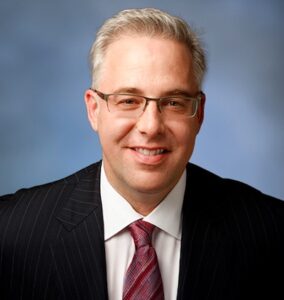April 10, 2024 • 7 Min Read
Terms like HIPAA, privacy and ethics have become part of the common healthcare industry vernacular over the last 20 to 30 years. But as Todd Gower, Chief Compliance Officer at L.A. Care, explains, regulatory compliance is just one critical aspect of a successful risk management practice.
L.A. Care Health Plan is the nation’s largest publicly operated health plan serving more than two million members. Its mission is to provide access to quality health care for Los Angeles County’s vulnerable and low-income communities and residents and to support the safety net required to achieve that purpose.
Gower first came on board at L.A. Care in 2021 as an RGP consultant supporting the revitalization of their internal audit program. Fast forward to September of 2023, the Chief Compliance Officer announced his retirement. Gower was tapped to fill the role on an interim basis and continue the work that was already underway to establish a more mature compliance practice. He was appointed to the role permanently in December of 2024.
“There are moments in your career when you get the call—the opportunity to go beyond surface-level support and truly drive meaningful change. When that call came, my answer was simple: ‘Yes. How can I deepen my impact and further L.A. Care’s mission? Why not?’” Gower reflects. “I was at a point where this step felt right. What made it even more compelling was the shared commitment across the leadership team—we all have a unified vision to improve the health and well-being of our members. That kind of alignment is both rare and energizing.

Todd Gower, L.A. Care Chief Compliance Officer
Evolving Compliance to Support the Organizational Mission
We spoke with Gower about his role at L.A. Care and how risk management and regulatory compliance are helping to support the organization’s mission. This includes helping L.A. Care raise awareness of compliance issues in the healthcare space and instilling leading practices into the organizational DNA, such as ensuring distinct lines of defense. It also encompasses broader risk considerations, such as financial risk and behavioral, reputational, and community health.
Can you tell us about the work you do as Chief Compliance Officer at L.A. Care?
At its core, my role as Chief Compliance Officer is about ensuring that L.A. Care operates with integrity, transparency, and accountability in everything we do. Compliance is not just about checking a regulatory box—it’s about protecting our members, maintaining trust, and mitigating risk across all areas of the organization. However, as a Chief, it’s not about doing the work and the team; it’s about involving the entire enterprise in this transformational journey.
One of my primary responsibilities is navigating complex state and federal regulations, ensuring that we as an organization and leadership team meet evolving compliance requirements from agencies like DHCS, DMHC, and CMS. This includes overseeing audits, minimizing penalties, and strengthening our fraud, waste, and abuse (FWA) program—with a strong emphasis on prevention rather than just detection.
Compliance is not just about checking a regulatory box—it’s about protecting our members, maintaining trust, and mitigating risk across all areas of the organization.
Compliance in the Digital Age
How has the COVID-19 pandemic and acceleration of digital transformation affected the compliance landscape?
Nearly all aspects of healthcare have moved online, making data privacy, cybersecurity, and interoperability top concerns. Compliance officers are now at the forefront of protecting sensitive health information while ensuring seamless data exchange across systems.
To tackle these challenges, we brought on a new Chief Information Security Officer (CISO) in 2022, and we’ve been working together to embed industry-standard cybersecurity frameworks (like NIST and HIPAA security standards) into our compliance operations. The goal is to stay ahead of emerging threats, not just react to them.
Financial and Provider Risk Oversight
Compliance doesn’t stop with regulations—it extends to financial solvency, provider qualifications, and member well-being. One key area we monitor is the financial health of our provider network, ensuring that providers remain stable and capable of delivering care.
Our CFO’s team works closely with compliance to align financial risk management with regulatory oversight, creating a first-line defense against financial vulnerabilities.
At the same time, we focus on ensuring that providers meet high standards of quality and performance. It’s not enough to be compliant on paper—we need to ensure that our members receive appropriate, high-quality care. That means evaluating risk exposure beyond traditional compliance measures, including social determinants of health, member attrition, and disparities in care.
At L.A. Care, we don’t see compliance as just avoiding penalties or passing audits—it’s about building a culture of accountability and ethical decision-making. Whether it’s strengthening fraud prevention, improving cybersecurity, ensuring financial stability, or enhancing provider oversight, my job is to ensure that every compliance initiative and L.A. Care supports our larger mission: protecting and improving the health of the communities we serve.
At L.A. Care, we don’t see compliance as just avoiding penalties or passing audits—it’s about building a culture of accountability and ethical decision-making.
A Holistic Approach to Compliance
How does risk management affect overall enterprise goals and strategy?
In a landscape filled with extensive guidance on compliance dos and don’ts, it’s crucial to remain focused and strategic. Not be the department of “No” but of “How?”
At our organization, we make a concerted effort to align our compliance goals and work plan with the overall strategic objectives of the organization while also ensuring we meet the regulatory requirements set forth by bodies like the Office of the Inspector General (OIG).
The OIG plays a key role in shaping our compliance efforts, outlining the specific areas of focus that both our organization and I, as Chief Compliance Officer, must prioritize. This alignment ensures that our compliance initiatives are not only regulatory-driven but also tightly integrated with our broader organizational goals.
OIG 7 Elements of an Effective Compliance Program
1
Implement written policies, procedures, and standards of conduct.
2
Designate a compliance officer and a compliance committee.
3
Conduct effective training and education.
5
Conduct internal monitoring and auditing.
6
Enforce standards through well-publicized disciplinary guidelines.
6
Enforce standards through well-publicized disciplinary guidelines.
7
Respond promptly to detected offenses and undertake corrective action.
How Flexible Workforce Strategies Can Support Sustainable Compliance
As someone who has supported healthcare organizations as both a consultant and as part of an internal leadership team, what is your perspective on the benefits of a Dynamic Workforce™ model?
Hiring the right talent can be a complex and time-intensive process, especially when you need to create a specialized job description or seeking professionals with multifaceted expertise. In today’s fast-paced regulatory landscape, organizations often require more than just a traditional hire—they need individuals with a Swiss Army Knife mentality, strong intellectual curiosity and who can quickly adapt, solve specific challenges, and seamlessly integrate into existing teams.
For short-term, project-based needs, finding the right talent is even more challenging. A hybrid, flexible consulting model offers a strategic solution, allowing organizations to bring in experts for defined periods—perhaps three, six and twelve months—before pivoting them to other high-priority initiatives.
This model, which I have used in the past as well as experienced as a consultant provides targeted support without the long-term commitment of a full-time hire, ensuring compliance and operational goals remain on track.
It’s also essential to recognize the distinction between staff augmentation and true consulting. While staff augmentation simply fills a vacancy, a consultant partners with process and system owners to assess, refine, and enhance workflows. They go beyond execution, asking critical strategic questions:
- What needs to change?
- Why is this change necessary?
- Is this the right time to implement it?
This insight-driven approach ensures that organizations don’t just fill roles—they enhance processes, drive efficiency, and maintain long-term compliance success.
In today’s fast-paced regulatory landscape, organizations often require more than just a traditional hire. They need individuals with a Swiss Army Knife mentality, strong intellectual curiosity and who can quickly adapt, solve specific challenges, and seamlessly integrate into existing teams.
RGP’s Differentiation
Many consulting firms emphasize agility, flexibility, and a client-first mindset, but what truly sets a firm apart is the depth of expertise and strategic perspective its consultants bring to the table.
At RGP, consultants like myself average 10 to 20 years of industry experience and the big 4, allowing them to go beyond simply providing solutions—they serve as trusted advisors, guiding clients through complex compliance challenges and evolving regulatory landscapes with confidence.
What drew me to RGP, aside from the leaders, was its commitment to a thoughtful, problem-first approach. Rather than offering generic solutions or quick fixes, I was able to take the time to deeply understand each client’s unique challenges. This ensures that every recommendation is tailored, sustainable, and aligned with the organization’s long-term strategic goals—a level of care and expertise that makes a real difference.
At its core, and what I enjoyed at RGP, was the human-centered approach—a culture that fosters genuine collaboration and lasting partnerships. What I found was that clients didn’t just turn to RGP for expertise; they rely on the firm for strategic guidance that drives meaningful, long-term success.
How does the human element influence your work today?
The human element is at the core of everything I do. At L.A. Care, our mission isn’t just about compliance and regulations—it’s about people our members. Whether it’s ensuring members receive the care they need, supporting providers in delivering high-quality services, or building a culture of trust and integrity within the organization, the human impact is always front and center.
Many of us in healthcare return to the industry because we’re driven by a sense of purpose. We see firsthand how policies, processes, and compliance decisions affect real lives—from the members relying on us for care to the providers navigating an increasingly complex system. That’s why my approach isn’t just about meeting regulatory requirements; it’s about understanding the human stories behind the data, the support we provide to improve the lives of our county.
This focus on the human first aligns with my experience at RGP, where consulting isn’t just about technical solutions but about listening, understanding, and collaborating to create meaningful change. At L.A. Care, that philosophy continues—ensuring that our work isn’t just operationally sound but truly makes a difference in the lives of those we serve.
